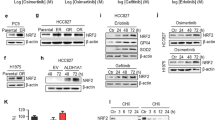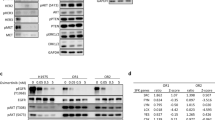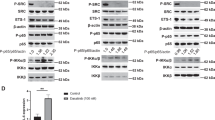Abstract
Resistance to chemotherapy is believed to be a major cause of treatment failure in pancreatic cancer. Thus, it is necessary to explore alternative therapeutic modalities to overcome drug resistance in pancreatic cancer treatment. We tested the hypothesis that Src tyrosine kinase inhibition could augment the chemosensitivity of 5-fluorouracil (5-FU)-resistant human pancreatic cancer cells to 5-FU. As detected by MTT proliferation assay, propidium iodide and annexin V staining, a combination of 5-FU+Src kinase inhibitor PP2 (4-amino-5-(4-chlorophenyl)-7-(t-butyl)pyrazolo[3,4-d]pyrimidine) reflected the chemotherapeutic sensitivity and restored the 5-FU-induced apoptosis in 5-FU-resistant cells. Furthermore, when small-interfering RNA approach to silence Src gene expression was applied, the degree of 5-FU-induced apoptosis was increased in all cell lines independently of the chemoresistance status. Western blotting and RT–PCR analysis revealed that the expression of thymidylate synthase (TS) was higher in 5-FU-resistant cells, however, decreased significantly after pretreatment with PP2. Furthermore, the combination of 5-FU+PP2 decreased the 5-FU-induced activation of epidermal growth factor receptor (EGFR)–AKT pathway. Finally, PP2 in combination with 5-FU substantially decreased the in vivo tumor growth and inhibited distant metastases. Taken together, 5-FU chemoresistance can be reversed through indirect TS regulation by inhibiting Src tyrosine kinase. A potential mechanism of action of Src kinase inhibitors on 5-FU chemosensitivity might be linked to the inhibition of 5-FU-induced EGFR–AKT activation.
This is a preview of subscription content, access via your institution
Access options
Subscribe to this journal
Receive 50 print issues and online access
$259.00 per year
only $5.18 per issue
Buy this article
- Purchase on Springer Link
- Instant access to full article PDF
Prices may be subject to local taxes which are calculated during checkout







Similar content being viewed by others
References
Beck A, Etienne MC, Chéradame S, Fischel JL, Formento P, Renée N et al. (1994). A role for dihydropyrimidine dehydrogenase and thymidylate synthase in tumour sensitivity to fluorouracil. Eur J Cancer 30A: 1517–1522.
Blaszkowsky L . (1998). Treatment of advanced and metastatic pancreatic cancer. Front Biosci 3: E214–E225.
Bruns CJ, Harbison MT, Kuniyasu H, Eue I, Fidler IJ . (1999). In vivo selection and characterization of metastatic variants from human pancreatic adenocarcinoma by using orthotopic implantation in nude mice. Neoplasia 1: 50–62.
Chu E, Allegra CJ . (1996). The role of thymidylate synthase as an RNA binding protein. Bioessays 18: 191–198.
Chu E, Callender MA, Farrell MP, Schmitz JC . (2003). Thymidylate synthase inhibitors as anticancer agents: from bench to bedside. Cancer Chemother Pharmacol 52: S80–S89.
Chu E, Koeller DM, Casey JL, Drake JC, Chabner BA, Elwood PC et al. (1990). Autoregulation of human thymidylate synthase messenger RNA translation by thymidylate synthase. Proc Natl Acad Sci USA 90: 517–521.
Collins AT, Berry PA, Hyde C, Stower MJ, Maitland NJ . (2005). Prospective identification of tumorigenic prostate cancer stem cells. Cancer Res 65: 10946–10951.
Crnogorac-Jurcevic T, Efthimiou E, Capelli P, Blaveri E, Baron A, Terris B et al. (2001). Gene expression profiles of pancreatic cancer and stromal desmoplasia. Oncogene 20: 7437–7446.
DeCaprio JA, Mayer RJ, Gonin R, Arbuck SG . (1991). Fluorouracil and high-dose leucovorin in previously untreated patients with advanced adenocarcinoma of the pancreas: results of a phase II trial. J Clin Oncol 9: 2128–2133.
Duxbury MS, Ito H, Zinner MJ, Ashley SW, Whang EE . (2004). Inhibition of Src tyrosine kinase impairs inherent and acquired gemcitabine resistance in human pancreatic adenocarcinoma cells. Clin Can Res 10: 2307–2318.
Frame MC . (2002). Src in cancer: deregulation and consequences for cell behaviour. Biochim Biophys Acta 1602: 114–130.
Gibson S, Tu S, Oyer R, Anderson SM, Johnson GL . (1999). Epidermal growth factor protects epithelial cells against Fas-induced apoptosis. Requirement for Akt activation. J Biol Chem 274: 17612–17618.
Goshal K, Jacob ST . (1997). An alternative molecular mechanism of action of 5-fluorouracil, a potent anticancer drug. Biochem Pharmacol 53: 1569–1575.
Hamaji M, Nishida T, Miyazaki S, Nishida Y . (2002). Dihydropyrimidine dehydrogenase and thymidylate synthase in colon carcinoma. Gan To Kagaku Ryoho 29: 889–893.
Hermann PC, Huber SL, Herrler T, Aicher A, Ellwart JW, Guba M et al. (2007). Distinct populations of cancer stem cells determine tumor growth and metastatic activity in human pancreatic cancer. Cell Stem Cell 1: 313–323.
Igney FH, Krammer PH . (2002). Death and anti-death: tumour resistance to apoptosis. Nat Rev Cancer 2: 277–288.
Johnston PG, Lenz HJ, Leichman CG, Danenberg KD, Allegra CJ, Danenberg PV et al. (1995). Thymidylate synthase gene and protein expression correlate and are associated with responce to 5-fluorouracil in human colorectal and gastric tumors. Cancer Res 55: 1407–1412.
Karni R, Jove R, Levitzki A . (1999). Inhibition of pp60c-Src reduces Bcl-XL expression and reverses the transformed phenotype of cells overexpressing EGF and HER-2 receptors. Oncogene 18: 4654–4662.
Kleespies A, Jauch KW, Bruns CJ . (2006). Tyrosine kinase inhibitors and gemcitabine: new treatment options in pancreatic cancer? Drug Resist Updat 9: 1–18.
Koizumi F, Kanzawa F, Ueda Y, Koh Y, Tsukiyama S, Taguchi F et al. (2004). Synergistic interaction between the EGFR tyrosine kinase inhibitor gefitinib (‘Iressa’) and the DNA topoisomerase I inhibitor CPT-11 (irinotecan) in human colorectal cancer cells. Int J Cancer 108: 464–472.
Kollmannsberger C, Peters HD, Fink U . (1996). Chemotherapy in advanced pancreatic adenocarcinoma. Cancer 78: 654–663.
Lönn U, Lönn S . (1984). Interaction between 5-fluorouracil and DNA of human colon adenocarcinoma. Cancer Res 44: 3414–3418.
Lutz MP, Esser IB, Flossmann-Kast BB, Vogelmann R, Lührs H, Friess H et al. (1998). Overexpression and activation of the tyrosine kinase Src in human pancreatic carcinoma. Biochem Biophys Res Commun 243: 503–508.
Major PP, Egan E, Herrick D, Kufe DW . (1982). 5-Fluorouracil incorporation in DNA of human breast cancer cells. Cancer Res 42: 3005–3009.
Masumoto N, Nakano S . (1997). Cell signaling and CDDP resistance. Gan To Kagaku Ryoho 24: 424–430.
Miyazaki Y, Hiraoka S, Tsutsui S, Kitamura S, Shinomura Y, Matsuzawa Y . (2001). Epidermal growth factor receptor mediates stress-induced expression of its ligands in rat gastric epithelial cells. Gastroenterology 120: 108–116.
Moore PS, Sipos B, Orlandini S, Sorio C, Real FX, Lemoine NR et al. (2001). Genetic profile of 22 pancreatic carcinoma cell lines. Analysis of K-ras, p53, p16 and DPC4/Smad4. Virchows Arch 439: 798–802.
Nam JS, Ino Y, Sakamoto M, Hirohashi S . (2002). Src family kinase inhibitor PP2 restores the E-cadherin/catenin cell adhesion system in human cancer cells and reduces metastasis. Clin Can Res 8: 2430–2436.
O'Brien CA, Pollett A, Gallinger S, Dick JE . (2007). A human colon cancer cell capable of initiating tumour growth in immunodeficient mice. Nature 445: 106–110.
Paul MK, Mukhopadhyay AK . (2004). Tyrosine kinase—role and significance in cancer. Int J Med Sci 1: 101–115.
Peters GJ, Backus HH, Freemantle S, van Triest B, Codacci-Pisanelli G, van der Wilt CL et al. (2002). Induction of thymidylate synthase as a 5-fluorouracil resistance mechanism. Biochim Biophys Acta 1587: 194–205.
Pinedo HM, Peters GF . (1988). Fluorouracil: biochemistry and pharmacology. J Clin Oncol 6: 1653–1664.
Popat S, Matakidou A, Houlston RS . (2004). Thymidylate synthase expression and prognosis in colorectal cancer: a systematic review and meta-analysis. J Clin Oncol 22: 529–536.
Salonga D, Danenberg KD, Johnson M, Metzger R, Groshen S, Tsao-Wei DD et al. (2000). Colorectal tumors responding to 5-fluorouracil have low gene expression levels of dihydropyrimidine dehydrogenase, thymidylate synthase, and thymidine phosphorylase. Clin Cancer Res 6: 1322–1327.
Shi X, Liu S, Kleeff J, Friess H, Büchler MW . (2002). Acquired resistance of pancreatic cancer cells towards 5-fluorouracil and gemcitabine is associated with altered expression of apoptosis-regulating genes. Oncology 62: 354–362.
Summy JM, Gallick GE . (2003). Src family kinases in tumor progression and metastasis. Cancer Metastasis Rev 22: 337–358.
Summy JM, Trevino JG, Baker CH, Gallick GE . (2005). c-Src regulates constitutive and EGF-mediated VEGF expression in pancreatic tumor cells through activation of phosphatidyl inositol-3 kinase and p38 MAPK. Pancreas 31: 263–274.
Szotek PP, Pieretti-Vanmarcke R, Masiakos PT, Dinulescu DM, Connolly D, Foster R et al. (2006). Ovarian cancer side population defines cells with stem cell-like characteristics and Mullerian inhibiting substance responsiveness. Proc Natl Acad Sci USA 103: 11154–11159.
Thomas SM, Brugge JS . (1997). Cellular functions regulated by Src family kinases. Annu Rev Cell Dev Biol 13: 513–609.
Van Schaeybroeck S, Karaiskou-McCaul A, Kelly D, Longley D, Galligan L, Van Cutsem E et al. (2005). Epidermal growth factor receptor activity determines response of colorectal cancer cells to gefitinib alone and in combination with chemotherapy. Clin Cancer Res 11: 7480–7489.
Voboril R, Hochwald SN, Li J, Brank A, Weberova J, Wessels F et al. (2004). inhibition of NF-kappa B augments sensitivity to 5-fluorouracil/folinic acid in colon cancer cells. J Surg Res 120: 178–188.
Wang W, Cassidy J . (2003). Constitutive nuclear factor-kappa B mRNA, protein overexpression and enhanced DNA-binding activity in thymidylate synthase inhibitor-resistant tumour cells. Br J Cancer 88: 624–629.
Wang W, Marsh S, Cassidy J, McLeod HL . (2001). Pharmacogenomic dissection of resistance to thymidylate synthase inhibitors. Cancer Res 61: 5505–5510.
Wang W, McLeod HL, Cassidy J . (2003). Disulfiram-mediated inhibition of NF-kappaB activity enhances cytotoxicity of 5-fluorouracil in human colorectal cancer cell lines. Int J Cancer 104: 504–511.
Wu Y, Hiwasa T, Isogai E, Sonoda T, Kita K, Chen Z et al. (1998). Activation of MAP kinases by 5-fluorouracil in a 5-fluorouracil-resistant variant human cell line derived from a KT breast cancer cell line. Int J Oncol 13: 1241–1245.
Yezhelyev MV, Koehl G, Guba M, Brabletz T, Jauch KW, Ryan A et al. (2004). Inhibition of src tyrosine kinase as treatment for human pancreatic cancer growing orthotopically in nude mice. Clin Cancer Res 10: 8028–8036.
Zhao Y, Shen S, Guo J, Chen H, Greenblatt DY, Kleeff J et al. (2006). Mitogen-activated protein kinases and chemoresistance in pancreatic cancer cells. J Surg Res 136: 325–335.
Acknowledgements
We thank AstraZeneca for providing with AZM475271. This research was supported by the grant of the clinical research group KFO 128/1-3 of the Deutsche Forschungsgemeinschaft (DFG) and the research grant GU 489/3-1 of the Deutsche Forschungsgemeinschaft (DFG) of the Schwerpunktprogramm ‘The tumor-vessel interface’. This report includes data that were generated during the doctoral thesis of Bettina Schwarz at the Medical School of the Ludwig-Maximilians-University, Munich.
Author information
Authors and Affiliations
Corresponding author
Rights and permissions
About this article
Cite this article
Ischenko, I., Camaj, P., Seeliger, H. et al. Inhibition of Src tyrosine kinase reverts chemoresistance toward 5-fluorouracil in human pancreatic carcinoma cells: an involvement of epidermal growth factor receptor signaling. Oncogene 27, 7212–7222 (2008). https://doi.org/10.1038/onc.2008.326
Received:
Revised:
Accepted:
Published:
Issue Date:
DOI: https://doi.org/10.1038/onc.2008.326
Keywords
This article is cited by
-
Thymidine phosphorylase induction by ionizing radiation antagonizes 5-fluorouracil resistance in human ductal pancreatic adenocarcinoma
Radiation and Environmental Biophysics (2022)
-
Natural compound Oblongifolin C confers gemcitabine resistance in pancreatic cancer by downregulating Src/MAPK/ERK pathways
Cell Death & Disease (2018)
-
Dasatinib blocks transcriptional and promigratory responses to transforming growth factor-beta in pancreatic adenocarcinoma cells through inhibition of Smad signalling: implications for in vivo mode of action
Molecular Cancer (2015)
-
Loss of Smad4 in colorectal cancer induces resistance to 5-fluorouracil through activating Akt pathway
British Journal of Cancer (2014)
-
Bosutinib plus capecitabine for selected advanced solid tumours: results of a phase 1 dose-escalation study
British Journal of Cancer (2014)



